PhotoRobot Virtual Catwalk First Use Guide
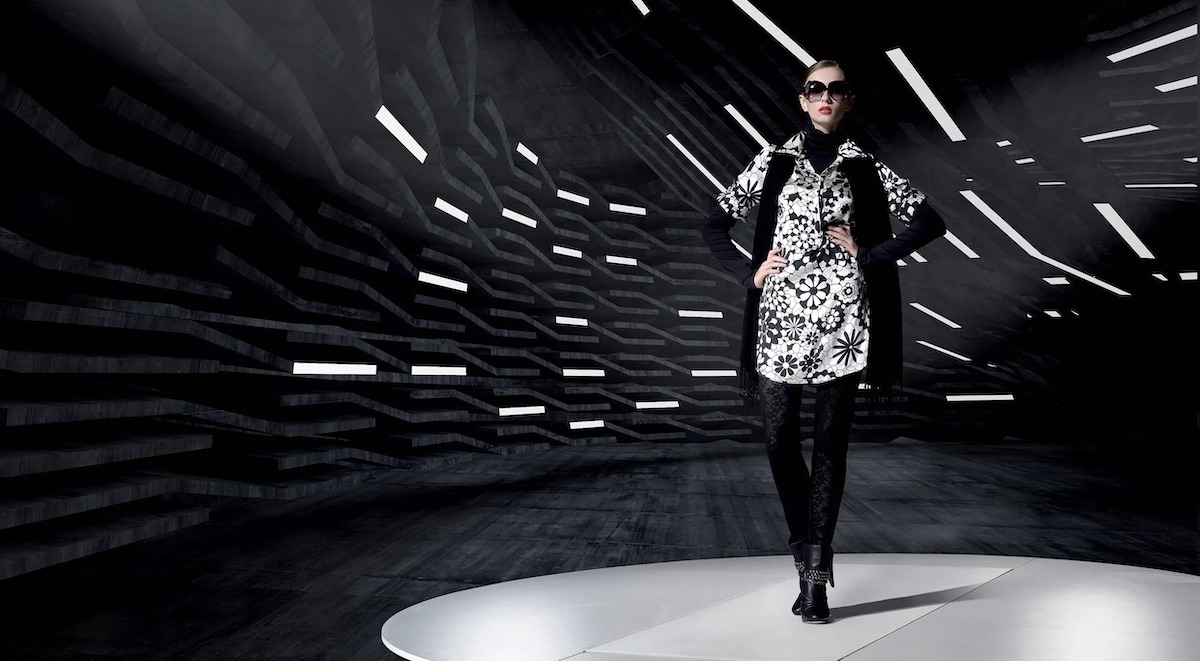
This user manual provides technical information for the basic understanding and functional operation of the PhotoRobot Virtual Catwalk. It aims to support PhotoRobot customers who have recently purchased their device, and to streamline onboarding of the new technology. This includes a general device overview of the Virtual Catwalk, instructions for connecting the device to the network, and steps for first use of the system.
Note: Always refer to PhotoRobot Safety Information & Instructions in addition to the manual provided specifically with your device before first use.
Important: The initial installation of a PhotoRobot device must always be carried out by an authorized PhotoRobot authority. Authorities with authorization to install PhotoRobot are an approved distributor, or a representative of the manufacturer itself.
First Use Guide to the PhotoRobot Catwalk
Thank you and congratulations on your PhotoRobot Virtual Catwalk purchase. Your PhotoRobot device represents decades of first-hand experience, insight, and innovation in automated photography. Its design is also with yours and every customer’s unique business in mind. PhotoRobot is modular to support widely ranging use cases, with each specific case helping to provide benefit to the entire PhotoRobot ecosystem. Use the following documentation to familiarize yourself with the PhotoRobot solution, and for instructions on first use of your device.
If encountering issues, refer to PhotoRobot Troubleshooting for solutions to common problems with hardware, robots, cameras, lights, editing, and post production.
1. Device Description - PhotoRobot Virtual Catwalk
PhotoRobot’s Virtual Catwalk in operation becomes an infinite 360 runway for fashion photography and video. The device consists of a treadmill on top of a rotating platform which rotates 360 degrees. At the same time, cameras remain in place around the platform, resulting in photos and video with a flying camera effect. The workstation is suitable for 360 product photography using models or photographing medium to large size objects when the belt is not running. There is also easy entry and exit from the platform, with adjustable speed for greater stability when in motion.
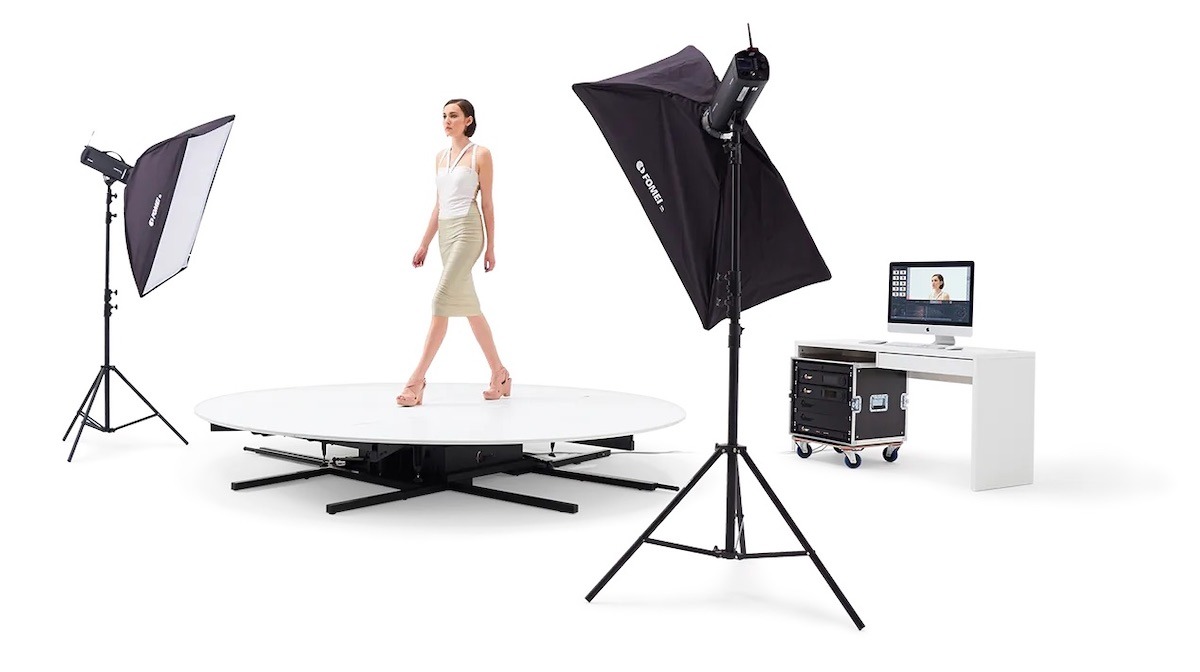
Key technological features of the PhotoRobot Catwalk include:
- Customizable movement control (with remote adjustment of turntable rotation and treadmill speed from 0 to 10 kmph to perfectly suit any model).
- Easy entry & exit (with the wide plate of the turning platform secured by supports for greater stability and safety).
- Everything in one place (with no need to move on or off location).
- Adjustable level (with the possibility to install the Catwalk directly into the floor to make it level with the working area).
1.1 Device Overview - Virtual Catwalk
The PhotoRobot Virtual Catwalk fits in a space of 7 x 7 meters, covering the rotational dynamics of the turning plate in combination with the walking belt. This enables two directions of movement. There is the movement of the walk-on treadmill-like belt, and then the rotating platform which is able to rotate simultaneously while the belt is in operation. Meanwhile, full control over direction and speed of movement together with mobile edge supports provide both safety and stability during device operation.

1.2. Main Components of the Virtual Catwalk
1.2.1. A massive drive motor in the machine enables adjustable speed control of the treadmill from 0 to 10 km/h, and drives the 360-degree rotation of the platform.
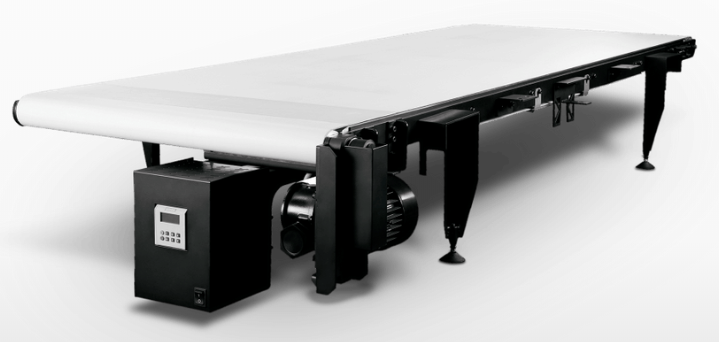
1.2.2. Note that the location of the Control Unit is not inside of the Catwalk. Instead, the Control Unit is separate from the machine, usually inside of a dedicated PhotoRobot HD rack case.

1.2.3. If the device is not in use to record video, it is possible to remove the belt and instead use the turntable for 360 product photography. This is possible in RotoPower mode, and also in combination with an optional PhotoRobot Robot Arm expansion.
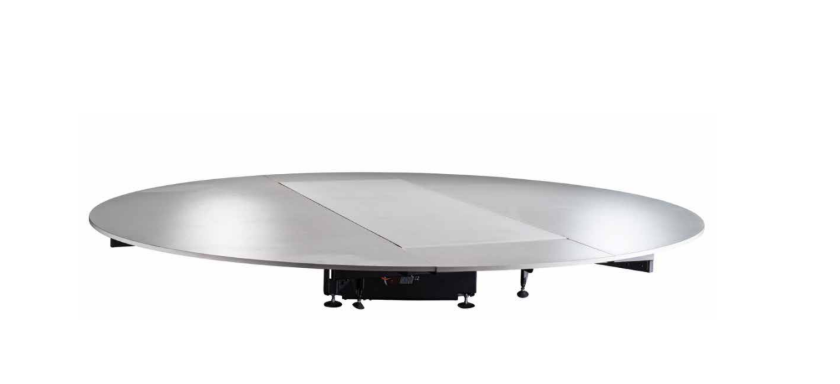

2. Before PhotoRobot Catwalk First Use
Before first use of PhotoRobot, it is necessary to understand the nature of the PhotoRobot solution. PhotoRobot is technically a modular unit which consists of hardware and software components. This requires PhotoRobot to have a connection to the same network as the computer operating it.
Important: Always refer to PhotoRobot First Use & Basic Testing for technical operating requirements and instructions on connecting PhotoRobot to the network.
In general, the following operation prerequisites must be met.
- The Control Unit must connect to the local network.
- A computer must run service GUI or the operator’s software called _Controls.
- The computer must connect over the same network as the Control Unit.
- There must be a functional internet connection over the network.
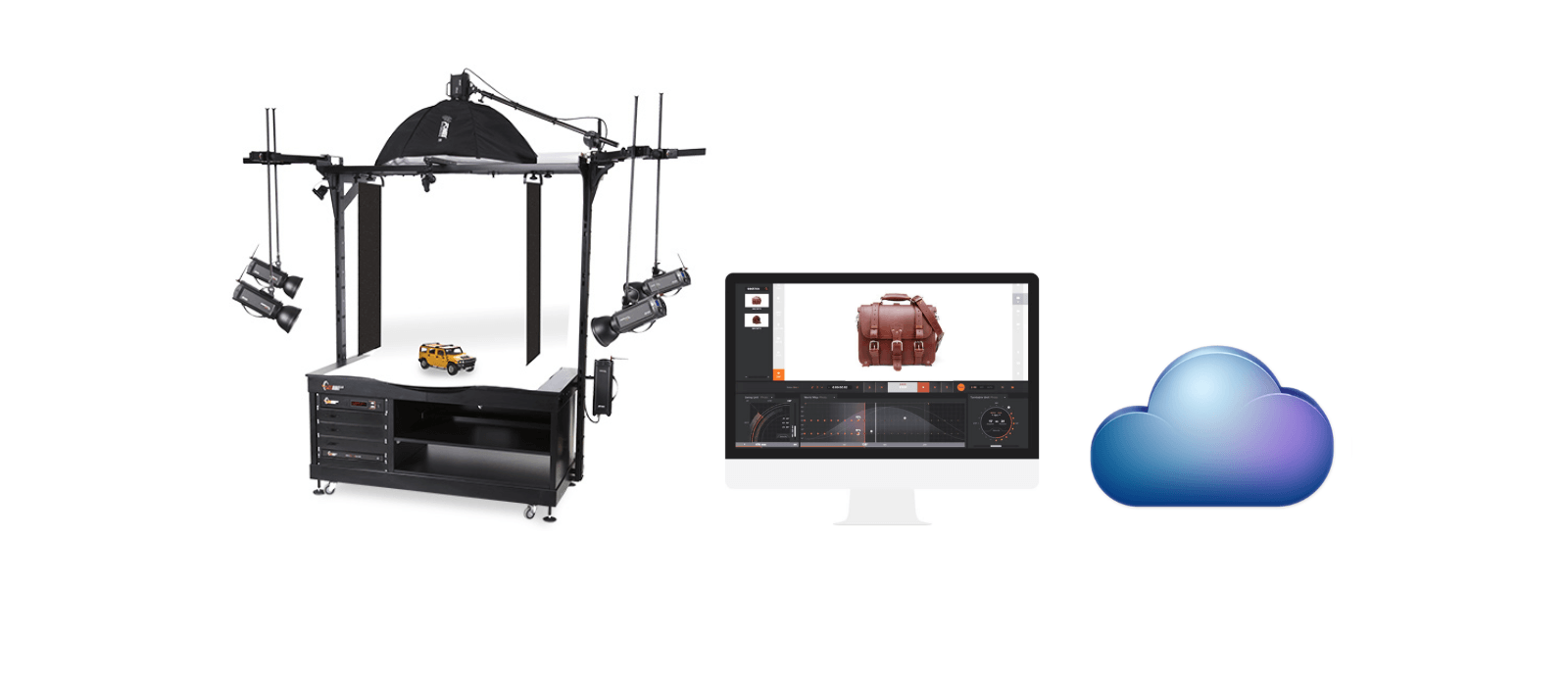
Additionally, the electricity distribution system parameters must be in compliance (e.g. voltage and frequency). To do this, use the RJ45 connector on the back of the Control Unit. If the setup of the Control Unit is not in compliance, set it up first. To do this, find the manual voltage selector on the back of the Control Unit. Then, connect the Control Unit to the network via ethernet cable using the RJ45 connector.

There are then the following network configuration requirements for operation of the Virtual Catwalk.
- A DHCP server in the network is mandatory.
- TCP ports 7777, 7778 communication must be allowed.
- UDP broadcasts on port 6666 must be allowed.
- Internet connection is mandatory.
- *.photorobot.com access must be allowed.
- as-unirobot.azurewebsites.net access must be allowed.
- Refer to PhotoRobot Networking Prerequisites & Configuration to confirm proper setup and for troubleshooting as necessary.
- Connect the power plug to the power socket.
Finally, press the mains switch on the Control Unit. When the status changes, the light will stop blinking and become a continuous light, signaling the Control Unit is ready for operation.
2.1. Find PhotoRobot’s IP address on LAN
To locate the IP address of the Virtual Catwalk and other PhotoRobot devices, use the following supporting applications to search the network for PhotoRobot.
- Windows - frfind for Windows
- Mac OS X - frfind for macOS
- Android - PhotoRobot Locator in Google Play
- iPhone, iPad - PhotoRobot Locator on iTunes
Note: After locating a PhotoRobot device using a supporting application, copy the IP address to paste into any web browser open on the computer. If successful, this will open the Service GUI, which will display a basic user interface for testing PhotoRobot.
2.2. Power on the PhotoRobot Catwalk
In the Service GUI of the device, next turn on the motor using the green power button Motor ON.

2.3. Run Basic Testing for PhotoRobot Catwalk
Finally, to test if PhotoRobot is fully operational, use the service GUI interface controls to turn the platform to any desired angle.
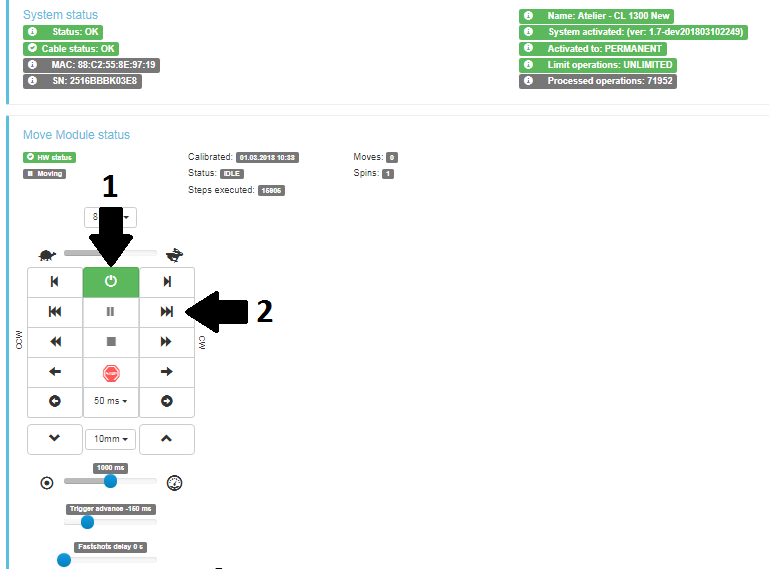
- Turn on the engines (arrow 1), try to rotate (arrow 2).
- If the robot follows the movement instructions, your PhotoRobot device is ready for regular operation.
3. PhotoRobot _Controls Software
The software PhotoRobot _Controls App provides control over the entire Virtual Catwalk robotic workstation. This includes remote control over all robots, cameras and lighting. The software manages workflow and provides the necessary functionality for effective automation in the field of post-processing.
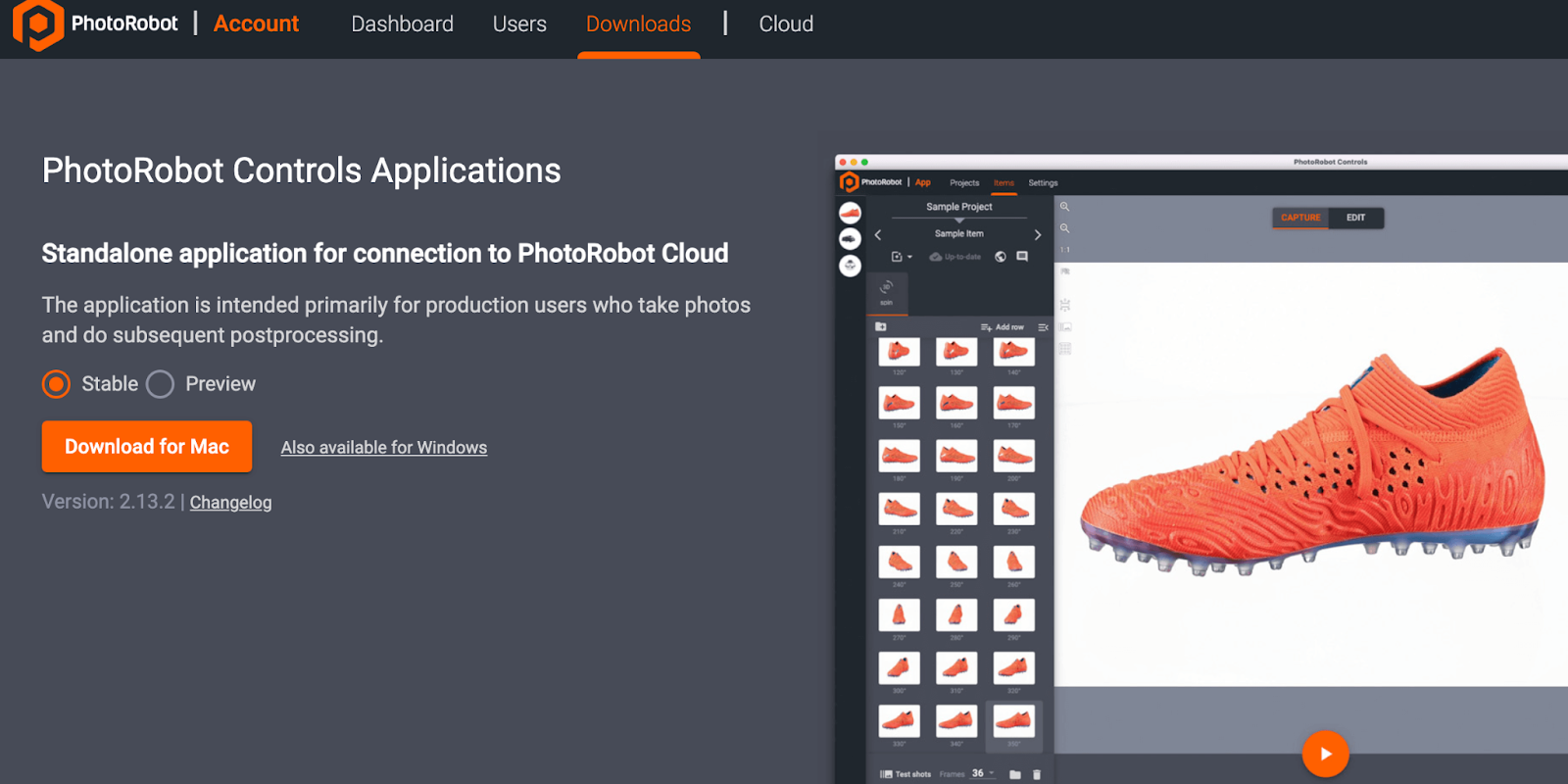
Important: PhotoRobot _Controls App software is available for download via your PhotoRobot Account. It is not included with the machine delivery; it is purchased separately from the machine.
Note: For detailed information and technical instructions on using PhotoRobot _Controls software, refer to PhotoRobot Getting Started.
4. Information Labels
4.1. Symbols Overview

4.2. Machine & Component Labels
For labels of specific machines and components, refer to the document PhotoRobot Safety Information and Instructions in the section Information Labels (3.1.).

The Canon EOS Rebel Series offers beginner-friendly DSLR cameras with solid image quality, intuitive controls, and versatile features. Ideal for photography enthusiasts, these cameras provide reliable autofocus, vari-angle touchscreens, and Full HD or 4K video recording.
Connection
Resolution (MP)
Resolution
The Canon EOS DSLR Series delivers high-quality images, fast autofocus, and versatility, making it ideal for both photography and video production.
Connection
Resolution (MP)
Resolution
The Canon EOS M Mirrorless Series combines compact design with DSLR-like performance. Featuring interchangeable lenses, fast autofocus, and high-quality image sensors, these cameras are great for travelers and content creators seeking portability without sacrificing image quality.
Connection
Resolution (MP)
Resolution
The Canon PowerShot Series offers compact, user-friendly cameras for casual shooters and enthusiasts. With models ranging from simple point-and-shoots to advanced zoom cameras, they provide convenience, solid image quality, and features like image stabilization and 4K video.
Connection
Resolution (MP)
Resolution
The Canon Close-Up & Handheld Cameras are designed for detailed, up-close photography and video. Compact and easy to use, they offer precision focus, high-resolution imaging, and versatile macro capabilities—perfect for vlogging, product photography, and creative close-ups.













